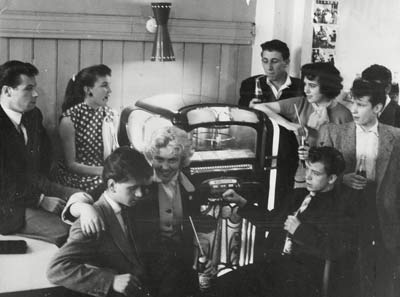rock 'n' roll

Rock 'n' roll was the genre of popular music that emerged when black R&B songs began to get airplay on radio stations aiming at a wider, predominantly white audience, and when white artists began re-recording black R&B songs. R&B, American country music, and 1940s and 1950s boogie-woogie music are all elements of early rock 'n' roll. Over time, rock 'n' roll mutated into the styles of rock. Two main youth subcultures were associated with rock 'n' roll: teddy boys and rockers.
Alan Freed, a Cleveland DJ, is usually credited with coining the phrase `rock 'n' roll' in the early 1950s. However, the style had been evolving well before this time. The term "rock 'n' roll", with its sexual connotations, was popularized in the music of the 1920s. In 1922, blues singer Trixie Smith recorded "My Daddy Rocks Me (With One Steady Roll)" for Black Swan Records, and various lyrical elaborations followed from other artists through the 1930s and 1940s.
In April 1954, Bill Haley and the Comets made "Rock Around the Clock". The record was a hit in America, then worldwide, eventually selling 15 million copies. It represented a critical symbol in the popularization of the new musical form. Subsequent major figures included Chuck Berry, Little Richard, and, in particular, Elvis Presley. The new music provoked considerable criticism, with many older musicians contemptuous of it.
Some criticism focused on the moral threat, rather than rock 'n' rolls perceived aesthetic limitations. To many, it appeared hostile and aggressive, epitomized by Elvis Presley's sensual moves.
From the 1960s on, rock 'n' roll diversified into many different things sub-genres, including progressive rock, punk rock, acid rock, heavy metal, country rock, glam rock, new wave, and alternative rock.
Originally a British phenomenon, teddy boys, or "teds", first appeared in the mid-1950s. Mainly from unskilled backgrounds, the teds had been left out of youth's new affluence. Their style included hair worn in elaborate quiffs,, dressed with grease, long, pseudo-Edwardian drape jackets (hence the name), thick crepe-soled shoes ("brothel creepers"), and thin string ties. The teds' music preferences were early rock 'n' roll and rockabilly. The teddy boys' activities centered around rock 'n' roll music, coffee bars and cafes with juke boxes, and pubs. They were involved in riots in cinemas and dance halls during the advent of rock 'n' roll, and in the 1958 UK race riots. There were teddy boy revivals in the 1970s and 1980s, although the dress and demeanor of the "modern teds" carried rather different connotations, being more reactionary and closer to their working-class machismo parent culture. In Britain in the 1960s, the teds evolved into rockers (also known as bikers, or greasers, especially in the US). The rockers wore black leather jackets, jeans, and boots, had greased hair and rode motorbikes. Largely low-paid unskilled manual workers, they were a male-oriented sub-culture; female followers rarely rode. The rockers' key value was freedom, and their preferred music was 1950s rock 'n' roll: Elvis, Gene Vincent, and Eddie Cochrane. The rockers clashed violently with the mods in 1963–1964 at southern English holiday resorts, producing a moral panic. They have never entirely vanished as an identifiable subculture.
Rock is the broad label for the huge range of styles that evolved out of rock 'n' roll. Rock is often considered to carry more weight than pop, with connotations of greater integrity, sincerity, and authenticity. Classic rock is a term originally used for a radio format concentrating on playing tried and proven past chart hits which will have high listener recognition and identification. Classic rock playlists are largely drawn from The Beatles to the end of the 1970s, and emphasize white male rock performers such as Cream, The Doors, Led Zeppelin, Creedence Clearwater Revival, and The Who. The format became prominent in part because of the consumer power of the ageing post-war baby boomers, and the appeal of this group to radio advertisers. Classic rock has also become a loosely defined genre and a general marketing category.


